Often referred to as the chocolate Shih Tzu or brown Shih Tzu, the liver Shih Tzu is one of the most unique-looking Shih Tzu puppies. People usually mistake this dog’s name because liver is not an actual color; it’s a pigmentation of the skin.
Skin points such as lips, paw pads, and rims of the eyes are liver, ranging from light to dark, depending on the genes present.
The dog may sport a brown coat, but that is not how the color is officially recognized.
What makes the liver color so special? How do the genes work to achieve such pigmentation? And how do you determine a liver Shih Tzu from the others?
About The Shih Tzu Breed: Origin, Coat Colors & Patterns

One thing you’ll notice immediately about Shih Tzus is their adorable face with large, dark eyes looking up at you. Then, you’ll see how this pup resembles the king of the jungle – the lion. Often called the “Lion Dog,” the Shih Tzu’s been around for a thousand years. That’s plenty of time to enjoy their lovely character and appealing looks.
Shih Tzus are classified as small dogs, weighing only 9 to 16 pounds and standing tall at 8 to 11 inches. Surprisingly, they’re quite solid for dogs their size.
The American Kennel Club (AKC) recognizes the Shih Tzu, even the liver Shih Tzu, as an official dog breed with quite a long lifespan of up to 16 years.
Shih Tzu dogs are known for their affection towards humans, especially children. Since they were used as lap dogs, today’s Shih Tzus are a good choice for living in apartments. Some dogs like to dig holes or chase squirrels, but the Shih Tzu is more fond of sitting on your lap, cuddling, and watching TV with you.
The Shih Tzu isn’t a menace to deal with. Things like dog food, groomer visits, or vet checkups aren’t an issue for many Shih Tzu owners. In fact, Shih Tzus are excellent dogs for people who suffer from allergies. They don’t shed and are considered hypoallergenic!
One thing that sets them apart from many other dog breeds is their huge variety of coat color combinations, patterns, and marks.
Here is a full list of recognized Shih Tzu coat colors:
• Solid Black: This is probably the rarest Shih Tzu color of them all. Also, it’s the most common-seen monochromic option. The solid color black is very rare. Usually, a black Shih Tzu will have a small splotch of color somewhere on its body.
• Solid White: White is another rare color for Shih Tzus. However, they do exist. Sometimes, other shades will sneak in, but the dog will be classified as white if most of its body is pure white, not cream. These dogs have black noses, which makes them look like little snowmen.
• Solid Blue: A blue Shih Tzu will look gray, but under the right light, the dog will impart a luminous blue shimmer. The blue shade is only a diluted black, and it occurs if the puppy’s parents have transferred the dilution gene to the puppy. A true blue Shih Tzu will have a blue coat and a blue nose.
• Solid Red: Even though we call them red Shih Tzus, these pups are actually orange in most light. Shih Tzu puppies can have a deep red coat, but the color changes and fades as the puppy grows into an adult dog.
• Silver: Some white Shih Tzus have a silver sheen to their coat, and thus, we refer to them as silver Shih Tzus.
• Gold: Although many dog breeds sport a gold coat, especially those with multi-colored coats, Shih Tzus in gold are pretty rare. The color will start as vivid and gleaming, but it will fade to a soft yellow once the dog matures. Gold Shih Tzus are often seen with a black mask.
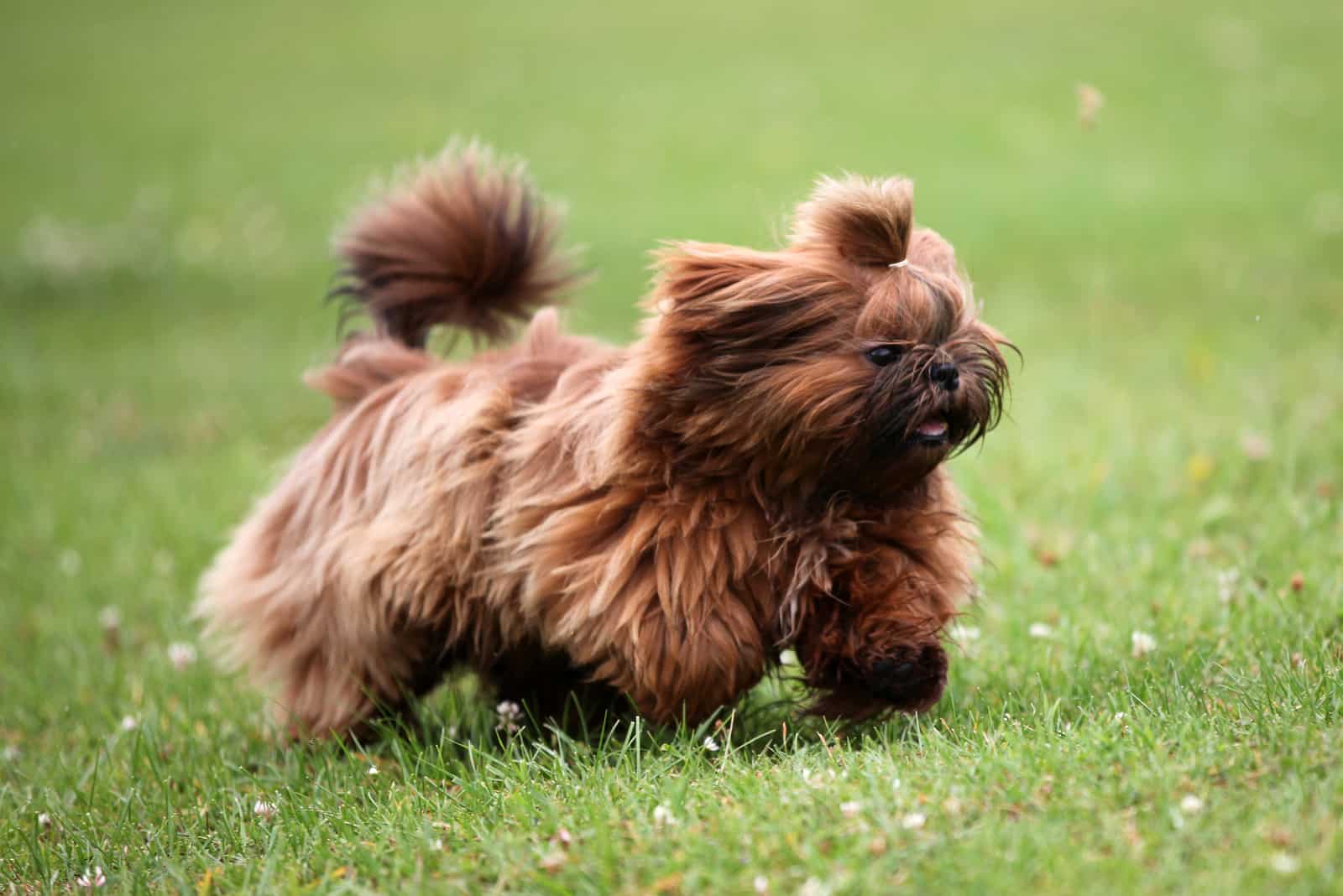
• Liver: The liver Shih Tzu, the star of our story, is sometimes called chocolate, but they are not exclusively brown. Sometimes they’ll have white patches on the chest. However, liver doesn’t refer to the dog’s coat color but its skin points like the lips, paw pads, and nose.
• Brindle: A brindle Shih Tzu has a solid-based fur streaked in another shade. These two shades could be just about anything; therefore, it’s not uncommon to see all brindle Shih Tzus.
• Double Colored: A double-colored Shih Tzu has two primary colors, but one of the shades is usually white. Black is the most common counterpart to the white coat, which means the black and white Shih Tzu is quite popular. However, any of the listed colors, even brindle, can be a part of the double-colored coat. A very rare double-colored Shih Tzu is a black one with tan points, also known as a Dobie Shih Tzu.
• Tri-Colored: These Shih Tzus are relatively rare and sometimes taken for granted since the third color is usually pale and faded. Gold and black are common combinations.
The Shih Tzu breed comes in a range of shades, but there are also markings in the following patterns:
• Shawl or Collar: A Shih Tzu with a solid color over much of its body, but with a diverse shade, usually white around the neck, is a Shih Tzu with a shawl or collar.
• Blaze: Blaze Shih Tzus have a white streak of color running between the eyes. It can go down beyond the neck or back. But, it always splits the eyes down the center.
• Flare: This pattern is almost identical to blaze, excluding the white patch as it broadens as it reaches the top of the dog’s head. A flare can take over the back and parts of the neck too.
• Tuxedo: This is a solid-colored Shih Tzu with some white on the chest and the feet. It truly appears as though the dog is wearing a tuxedo.
• Saddle: This pattern appears as a bit of color, usually white, which sits on the dog’s back just like a saddle on a horse.
How To Identify A Liver Shih Tzu

Photo from: @heylilbowie
The biggest question when it comes to liver Shih Tzus is whether your Shih Tzu is truly liver or not. Well, the first thing you do to check if a dog is liver is to look at the nose. If the nose appears to be brown, then it is a liver-colored dog. For example, a brown and white Shih Tzu must have a brown or liver nose to be classified as a liver Shih Tzu.
A black nose with brown and white fur may, in fact, be red and white instead. In other words, what seems brown may actually be a dull red combined with white.
The best way to tell is to put your Shih Tzu under direct sunlight. The red or rust color will appear quickly. Other combinations include brindle or gold and white or other colors instead of liver.
Sometimes, a Shih Tzu puppy is born solid brown, but, in some cases, the coat will become lighter over time as the puppy matures. Or, if the coat is closer to black, it will become darker. In both cases, it’s the genes that determine the amount and shade of the color as the Shih Tzu puppy matures.
Brown/Liver Vs. Black Shih Tzus
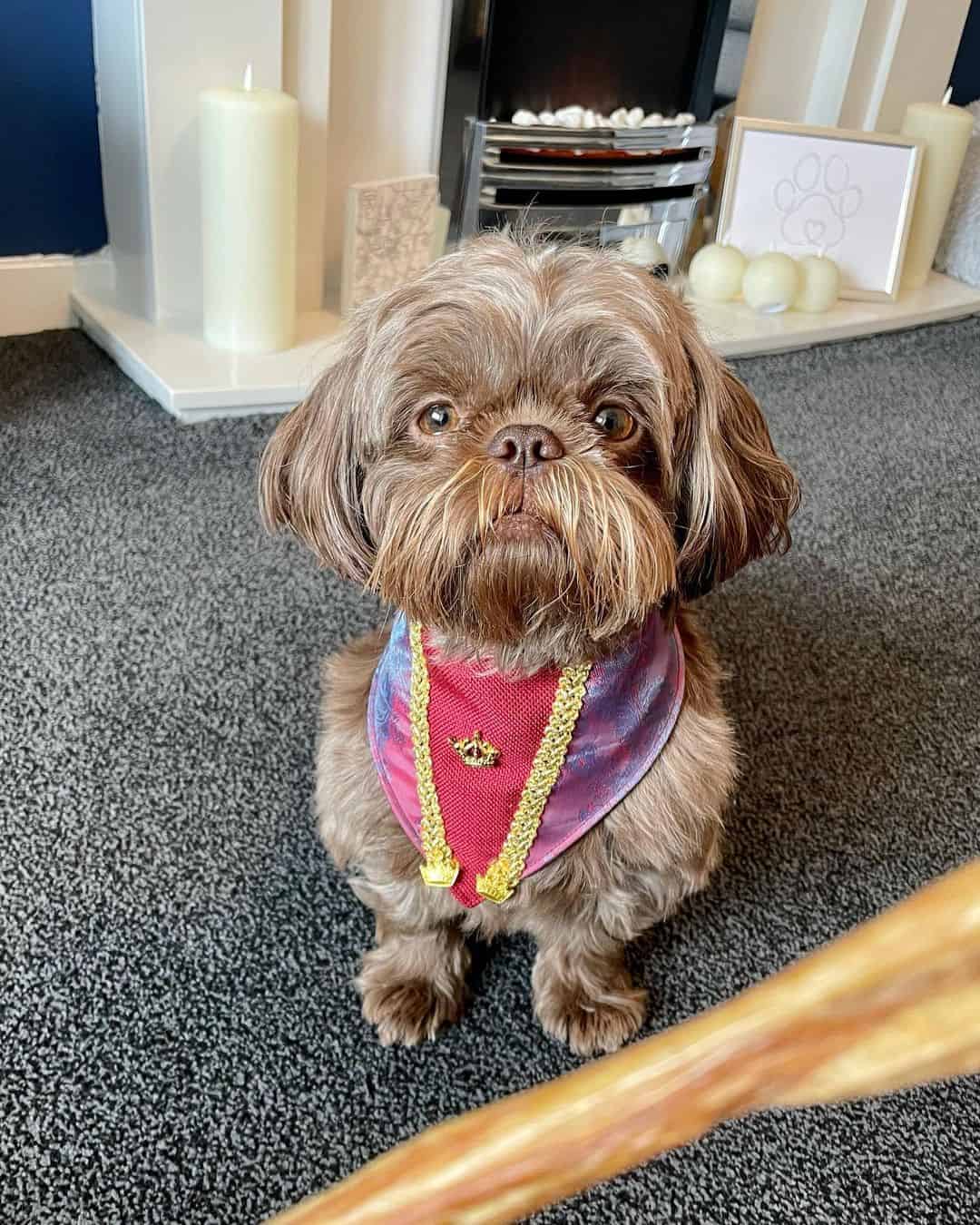
Photo from: @lord_poddington
All-brown Shih Tzus are rare, but so are all-black Shih Tzus. In most cases, the black coat will have white markings. This denotes the presence of a gene that generates white markings in all dogs, including Shih Tzus.
When it comes to determining the difference between black and brown Shih Tzus, it may be difficult depending on how dark the shade of brown or liver is present. A black Shih Tzu will have a black nose, but liver Shih Tzus will have a liver-colored nose.
Another sign is when a black Shih Tzu puppy matures, the fur may change over time. It is not uncommon for a black Shih Tzu puppy to turn almost silver as it becomes an adult Shih Tzu. Also, exposure to sunlight may change the coat’s shade, especially if the dog spends lots of time outdoors.
AKC’s Stand On The Liver Color
Liver (AKC color code S 123) is a lovely color shade seen in the Shih Tzu breed, but also in many others. Just like the blue color, even though blue is not rare, liver is based on skin pigmentation and not the color coat.
Liver itself is a type of brown color ranging in hues from light brown with a shiny pink overlay to a deep dark chocolate brown.
What Is The Liver Gene?
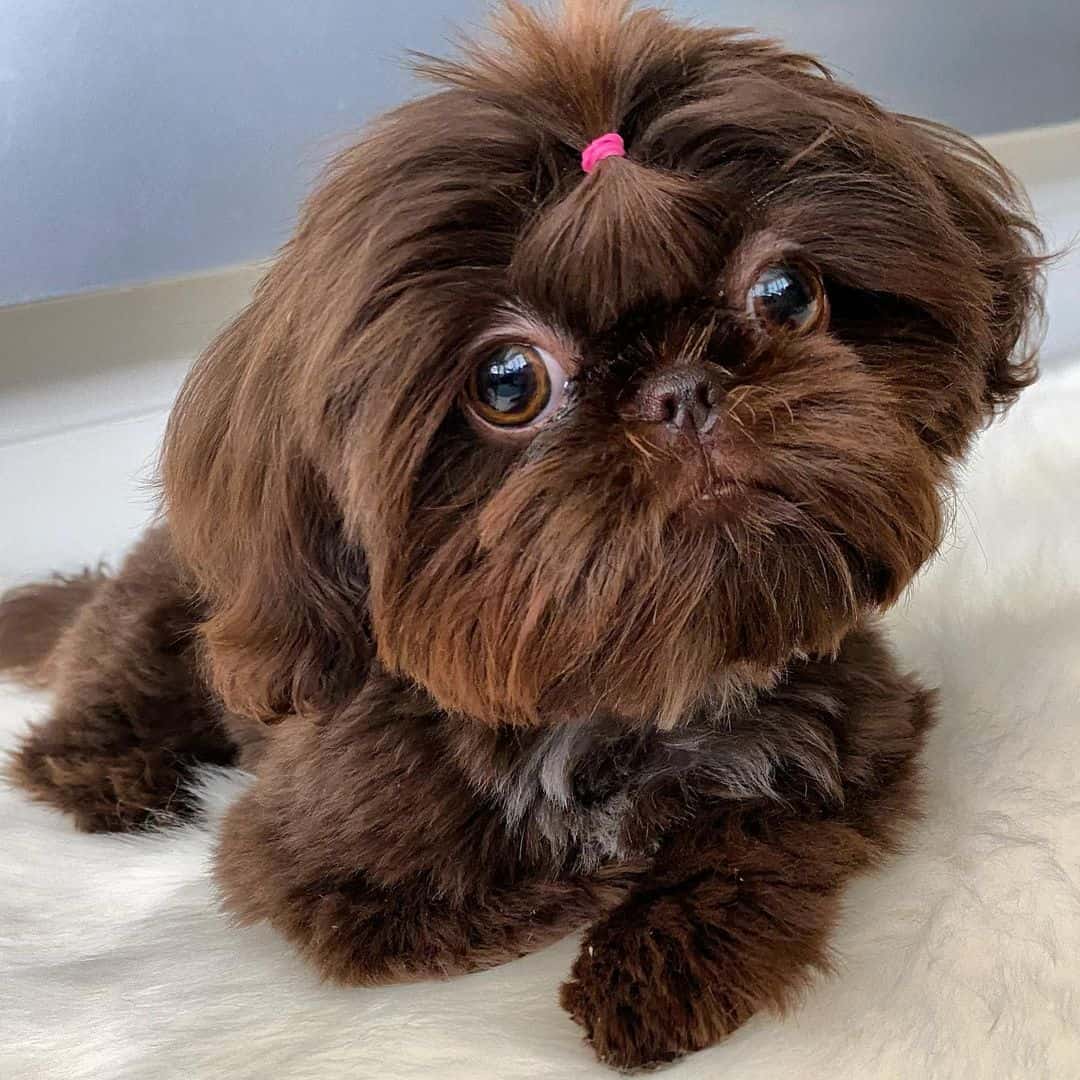
Photo from: @realrubytheshihtzu
The liver gene occurs on the B locus. It causes a brownish color. Also, it is recessive, so b is liver and B is non-liver. For a dog to be liver, it must have the genotype bb. This means a liver puppy can be born from black parents if both are carriers of the liver allele. For example, if both are Bb, then at least one puppy in four will be a bb.
The different pigment color genotypes are:
• BBdd or Bbdd – blue (non-liver, dilute)
• BBDd or BBDD – black (non-liver, non-dilute)
• bbdd – Isabella (liver, dilute)
• bbDd or bbDD – liver (liver, non-dilute)
The liver gene affects eumelanin or the black pigment only. The black in the coat may turn liver or brown when a dog is bb on the B locus. This includes saddles, shading, and merle dogs.
Genetically speaking, it’s impossible for a liver dog to have even one black or grey hair on its coat. Don’t be tricked by the bronzing or seal shades. They may appear liver, but they really are not.
A liver dog may have some red pheomelanin hairs depending on the K and A locus alleles present.
Sometimes a liver dog is described as a dilute one. Well, liver is not technically a dilution; it’s just a different color of eumelanin. Dilution in dogs is controlled by a separate locus and causes blue or Isabella/lilac Shih Tzus.
Liver turns the nose brown and the eyes amber or light brown. Sometimes liver dogs may have a pink nose. The nose color is usually the most reliable way to tell which dogs are liver and which are not.
Sometimes dogs are born with only pheomelanin or red pigment in the coats, like sable or recessive genes in red Shih Tzus, but they still have one of the eumelanin colors (blue, black, liver, or Isabella). This pigment will be visible in the nose color.
Black, blue, liver, or Isabella pigment means that if a dog has eumelanin in its coat, it will be that particular color. If there’s no eumelanin in the coat, there will be some in the nose and eyes. The pigment color can still be identified.
Even though we’re talking about alleles b and B, there are various different recessive alleles that cause the liver color, all located on the B locus. They’re often labeled bc, bd, and bs. Many dog breeds carry more than one of these alleles, but bs and bd are the most common ones, while bs is rare.
The alleles can be combined, i.e., one bc and one bd, but the result will still be liver.
The differences in shades of liver are probably the result of other modifiers or environmental factors.
When testing a dog for liver genes, make sure your lab does all tests for all of the known liver variants; otherwise, you won’t have an accurate result.
Liver Shih Tzu Look-Alikes
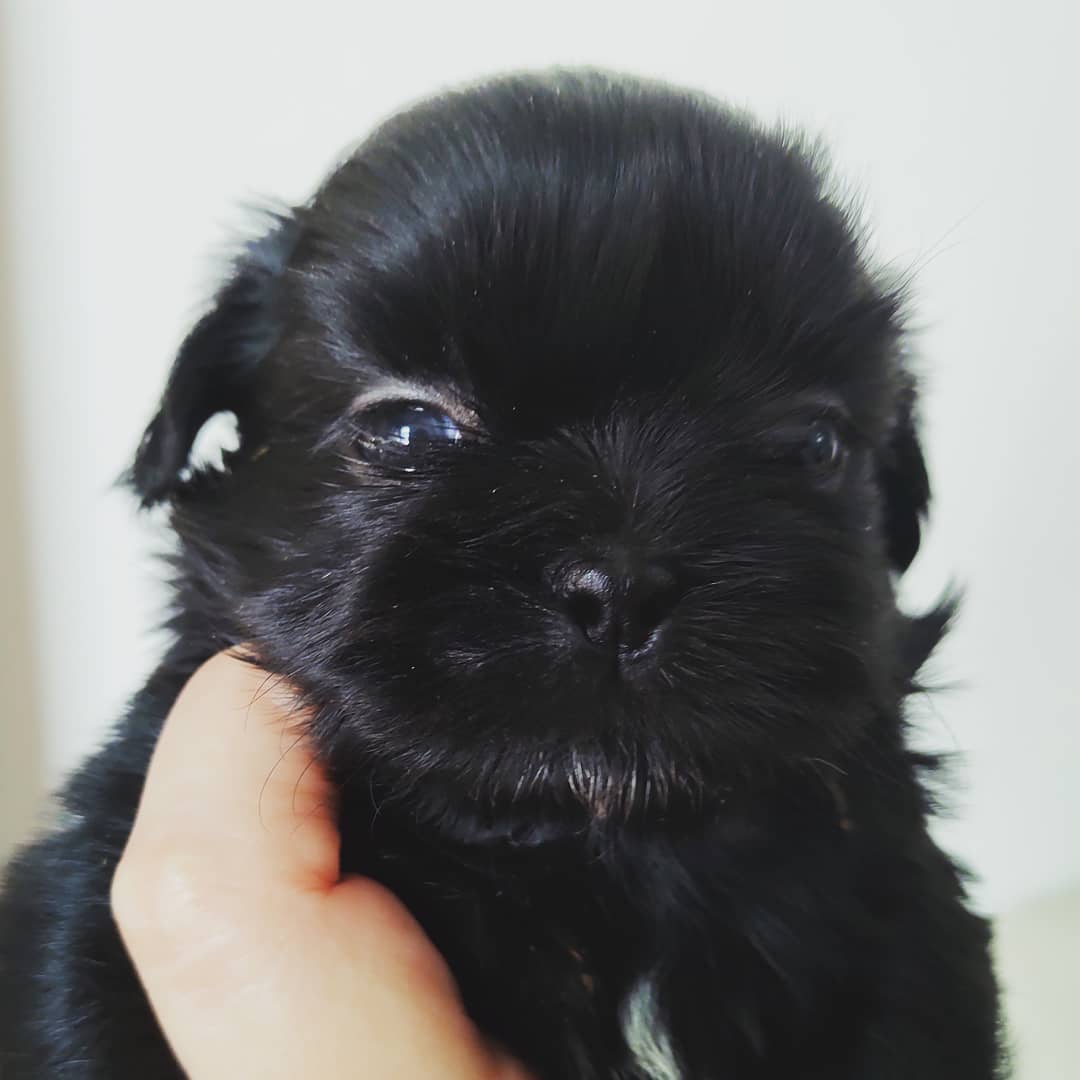
Photo from: @cosmicloveshihtzu
There is a dark shade of red (pheomelanin) that looks very similar to liver. This color is mainly found in dogs like the Irish Setter and Welsh Springer Spaniel. These dogs can be distinguished from livers by their black nose pigment.
What you need to be careful about is not to mistake a solid black Shih Tzu for a liver one. Sure, this may sound a bit silly, but it’s a pretty common mistake, especially in longhaired Shih Tzus.
When a black dog has long hair, the hair may turn a brownish shade. This happens a lot if the dog is outside for too long. It’s called bronzing and has no genetic basis. It’s completely environmental. It may be difficult to set apart black from liver in a photo, but in person, it’s much easier.
The last similar pattern is called seal, and it makes the dog look brownish. Seal consists of a black topcoat and a reddish undercoat. So, when the undercoat shows through, the dog may appear as liver. Sometimes it may even appear solid black!
The Gene Behind The Liver Color
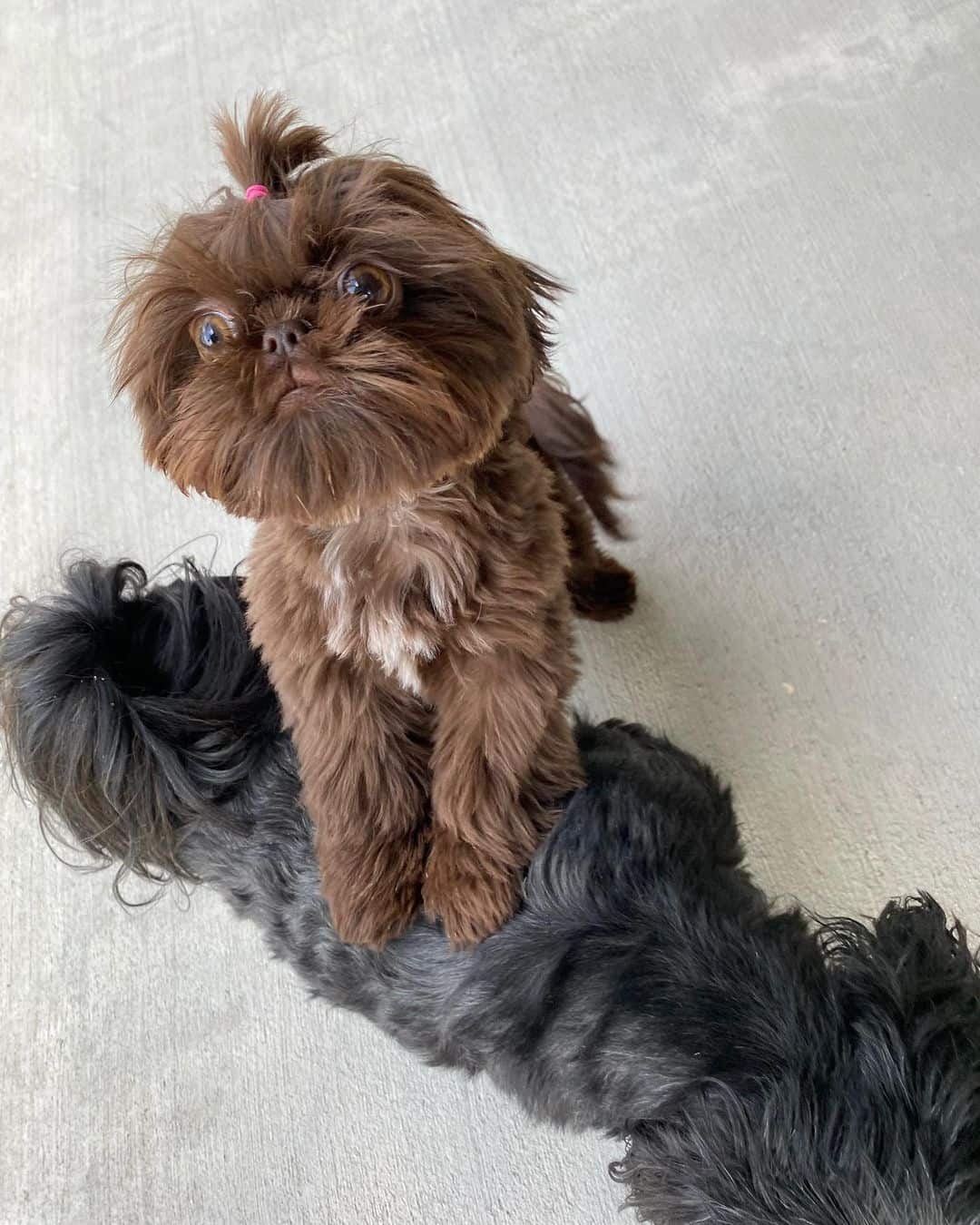
Photo from: @realrubytheshihtzu
The gene that causes liver in dogs is TYRP1 (Tyrosinase Related Protein 1). Also, similar mutations in the same gene are responsible for brown phenotypes in many animal species, including dogs.
In most species, these mutations are recessive, even though dominant and co-dominant brown alleles are not unknown.
TYRP1 in dogs is a modifier of eumelanin and not a dilution. A dilution gene only affects the density of the pigment, which results in a paler phenotype. TYRP1 changes the shape of the pigment molecules. The new shape means the pigment reflects light in a different way. This causes a brown phenotype instead of black.
The existence of different versions of the b allele in dogs implies that the mutation occurred separately several times. Interestingly enough, all of the b alleles are absent from some dog groups, usually in Asian breeds like our Shih Tzu.
Facts About Liver Shih Tzu Dogs
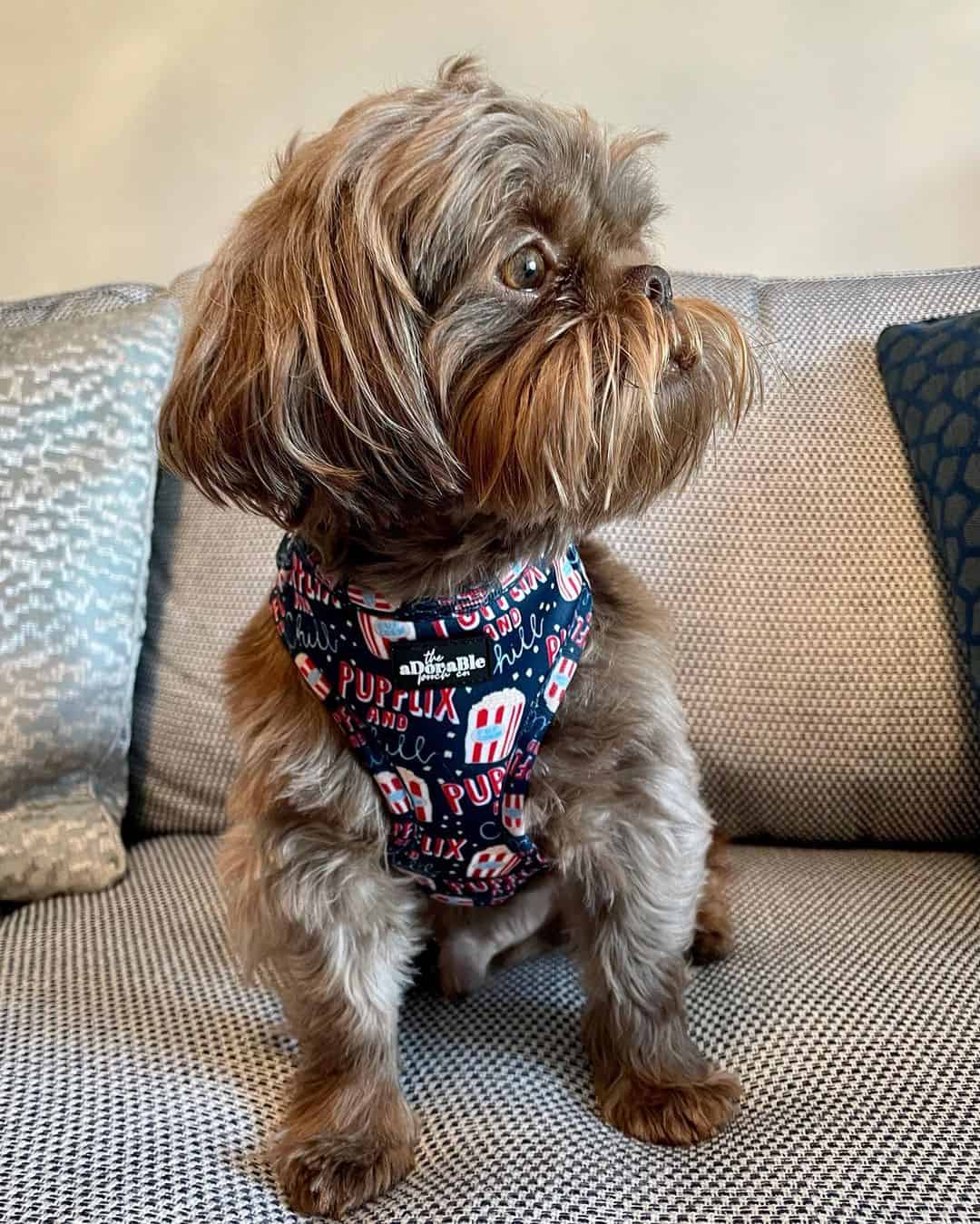
Photo from: @lord_poddington
Here are some interesting and helpful facts that might help you understand livers better:
• Liver is an official and AKC accepted color with the Shih Tzu breed. It’s a standard color, not an alternate one, with liver being S 123 and liver and white being S 125.
• It doesn’t matter which coat color a Shih Tzu sports. If its nose, eye rims, lips, and paw pads are in liver, it will be classified as a liver dog.
• The nose will always tell you whether a Shih Tzu is liver or any other color. So, if in doubt, take a look at that adorable button nose!
• A Shih Tzu’s coat can come in almost any color, but it’s usually in shades of brown and gold. The shades can range from very light to light cream, all the way to deep dark chocolate. This means solids, too, double-colors, and tri-colors.
• Some Shih Tzus, like black ones, will never have a liver nose.
• An inexperienced breeder may make a mistake and register a gold and white Shihtzu with a liver nose as a gold and white one. This is absolutely wrong, and the dog should be classified as liver.
• The coat coloring may be okay, but the designation would be wrong.
• Other dog breeds like Cocker Spaniels, English Springer Spaniels, and Dalmatians can be liver too, but they will go under a different name. For example, a liver Pomeranian is called a beaver Pomeranian.
• A Shih Tzu that is obviously liver will be a bb.
• A Shih Tzu can be a carrier of the liver gene, but it doesn’t have to show it. If a Shih Tzu carries only liver, he’s a b and not a bb. And, if it doesn’t carry liver, he’s a B or black, more specifically a Bb.
• Liver is recessive to black. For a dog to be liver, one of the following scenarios must happen: a) both parents must be liver, b) one of the parents is liver while the other is a carrier, c) both parents are carriers. In other words, even dog parents that don’t seem like they’re liver can have at least one liver puppy.
• If you breed Shih Tzus that are liver carriers, their litter may consist of both black and liver pigmented puppies. For example, if male and female Shih Tzus have black skin points (B) and carry liver gene (b), they may have puppies with bb or Bb.
• The liver allele affects the B gene (black). This allele turns all the areas of the coat that would be black to liver. This is an “all or nothing process.” In other words, a liver dog with even the slightest amount of black hair? Impossible!
What Happens If You Dilute Liver?

Photo from: @precious_woofs
Well, unofficially, it will give you a lavender Shih Tzu, but the dog will be registered as a regular liver. This is especially rare and quite beautiful. With so much dilution, the eyes will appear very light amber or green.
What Is A Liver Nose Shih Tzu?
Eumelanin or the black pigment colors a dog’s nose. That’s why a liver dog will have a liver-colored nose. If the nose is black, the dog won’t be liver.
A recessive red liver will still be born with a liver nose and amber or yellow eyes. It’s common for the nose of any recessive red dog to fade to pink as they become older, so a liver dog will have a liver colored nose. If the nose is black, the dog is not liver.
Is A White Liver Shih Tzu Combination Possible?

Photo from: @shihtzumaniac_donjuanx
Yes, a white liver Shih Tzu is possible, but it is also rare.
Since Shih Tzus in a liver color range from the very light to the deepest chocolate brown shades, having a white liver Shih Tzu puppy is surely possible.
Liver And White Shih Tzus For Sale
Liver and white Shih Tzus can be found at a good Shih Tzu breeder. Never buy from unreliable sources or even puppy mills!
A liver and white Shih Tzu can cost at least $1,200, but the price can even go up if the puppy is a top-quality one.
Liver Shih Tzu Puppies: How Much Are They?
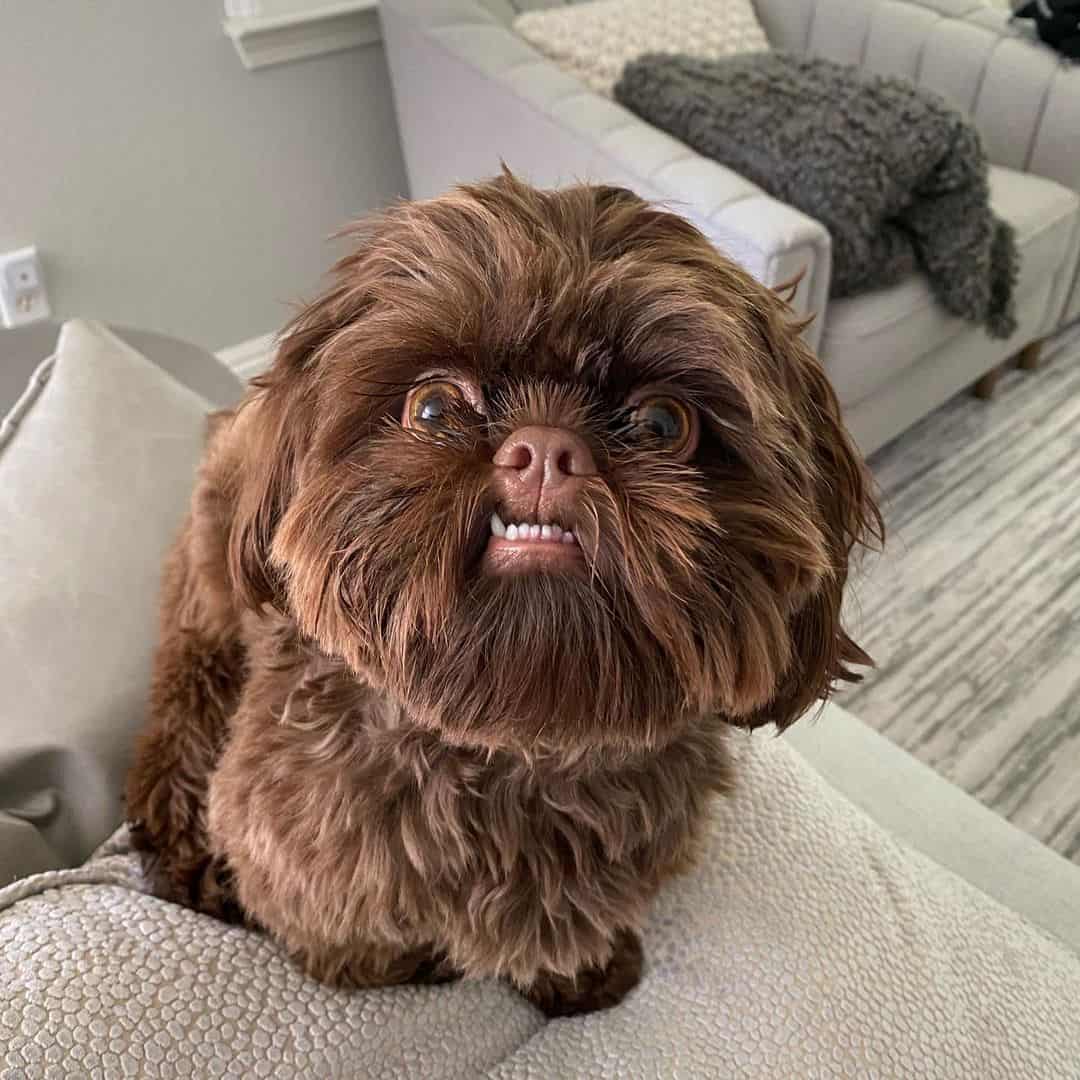
Photo from: @kiwisforall
AKC recognized liver Shih Tzu puppies are quite expensive. They can cost up to $3,500 for premium puppies.
The cheaper the Shih Tzu puppy, the higher the possibility they will be on the sick side.
Conclusion
Sure, liver Shih Tzus are rare beauties, but being liver doesn’t have any effect on the dog’s personality. In fact, coat color, no matter which one it is, will never affect a dog’s temperament.
All Shih Tzus are wonderful animals. Treat them the way they deserve, and you’ll get unconditional love in return. Doesn’t get better than that, does it?















